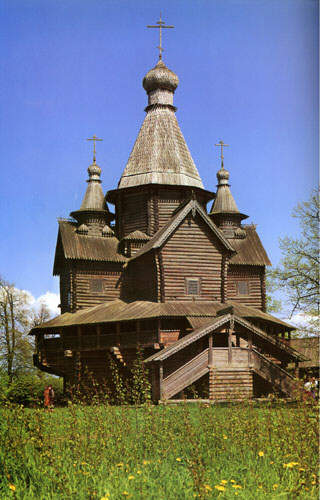
Long ago, in the 12th century, the small village of Vitoslavlitsy was situated here, on the way between Novgorod and the Yuriev monastery. Many other small monasteries like the Panteleimonov, the Annunciation monastery, the Arkazhsky etc., were located close by. Neither the village, nor the majority of the monasteries have survived (the only exception is the Annunciation monastery), but the historical landscape remained intact - all those meadows, lakes, and streams which proved to be so attractive that in 1960 this place was chosen for the creation of an open-air museum.
Old dilapidated constructions were brought here from all over the region. After the restoration work was completed the place became one of the city's most famous sites, a favorite of both the locals and the city's visitors. A city bus stops right at the museum's gates. One can see the outlines of roofs and domes of numerous churches and belfries, suggesting a life totally different from the habitual modern one. And the visitor's guess is justified once he/she sets foot on the village's main street where Russian izby (log huts) stand in perfect order facing each other, their low roofs covering both dwellings and storage areas.
A smiling hostess, dressed in a costume characteristic of the Novgorod village style of the last century, will meet you at the threshold and invite you in. She will show you around the back yard and the vegetable garden, the hayloft and cattle stalls, pointing out and explaining the meaning of items that might be unknown to you. Inside the izba, among dozens of artifacts, collected during expeditions, including furniture, utensils, expressive "trifles" like wrought-iron stands for torches, painted cabinets, spinning wheels and village "red"-icons you can have a little rest, look around, wondering at the simplicity of life in the old days and speculating how such a tiny space could accommodate a huge family, take a peek at the polati (a space on the large Russian stove) where children usually slept, try on the original lapti (shoes made of Birch-bark), or pose in front of a camera next to the hospitable mistress of the house. In a gallery next to the hut you will be offered a selection of souvenirs made of Birch-bark or wood and shown how to work with these materials. izba, among dozens of artifacts, collected during expeditions, including furniture, utensils, expressive "trifles" like wrought-iron stands for torches, painted cabinets, spinning wheels and village "red"-icons you can have a little rest, look around, wondering at the simplicity of life in the old days and speculating how such a tiny space could accommodate a huge family, take a peek at the polati (a space on the large Russian stove) where children usually slept, try on the original lapti (shoes made of Birch-bark), or pose in front of a camera next to the hospitable mistress of the house. In a gallery next to the hut you will be offered a selection of souvenirs made of Birch-bark or wood and shown how to work with these materials.
The two-story house of the first quarter of the 19th century, built for countess A. Orlova-Chesmenskaya, houses a stationary exhibition entitled "Folk Art of the Novgorod Region."
Twice a year, at the time of Sviatki (Christmas) and Troitsa (Whitsun), folk holidays are organized in Vitoslavlitsy. In winter people slide down snow slopes in sleds or on foot, sing songs and play traditional Russian games.
In summer folklore groups from all over the region gather in Vitoslavlitsy. Each small lawn becomes a place for round dancing, and songs follow one another. At the play grounds both the children and their parents try to learn stilt-walking and "huge-steps," play national games, gather in teams to pull the rope. Visitors interested in souvenirs are welcome at the nearby fair. All the traditional handicrafts, including the Birch-bark articles, wood carving and painting, hand-made woven items, clay penny-whistles, etc., are presented here. Visitors interested in souvenirs are welcome at the nearby fair. All the traditional handicrafts, including the Birch-bark articles, wood carving and painting, hand-made woven items, clay penny-whistles, etc., are presented here.
The Vitoslavlitsy museum is not only a place for strolls, rest and fun-making. This is also an architectural and natural museum, which contains different types of surviving wooden churches: the hip-roofed (eight edges over four edges) Church of the Assumption brought here from Kuritsk (1595), the Church of the Virgin's Nativity from the Peredki village (1531), the multiple-tiered church of Nikola from the Vysoki Ostrov (1767) and the Church of St. Nicholas from the Tukhol village (1688).
All in all a territory of just 30 ha accommodates 22 monuments. According to the city's general plan their number will increase to 70. They will give the visitor a good idea about traditions of the old life in different districts of Novgorod, varying from one another by natural conditions, economic activities, building traditions and some elements of spiritual culture.
|













 Pearls of Russia
Pearls of Russia  Museums and memorial estates
Museums and memorial estates